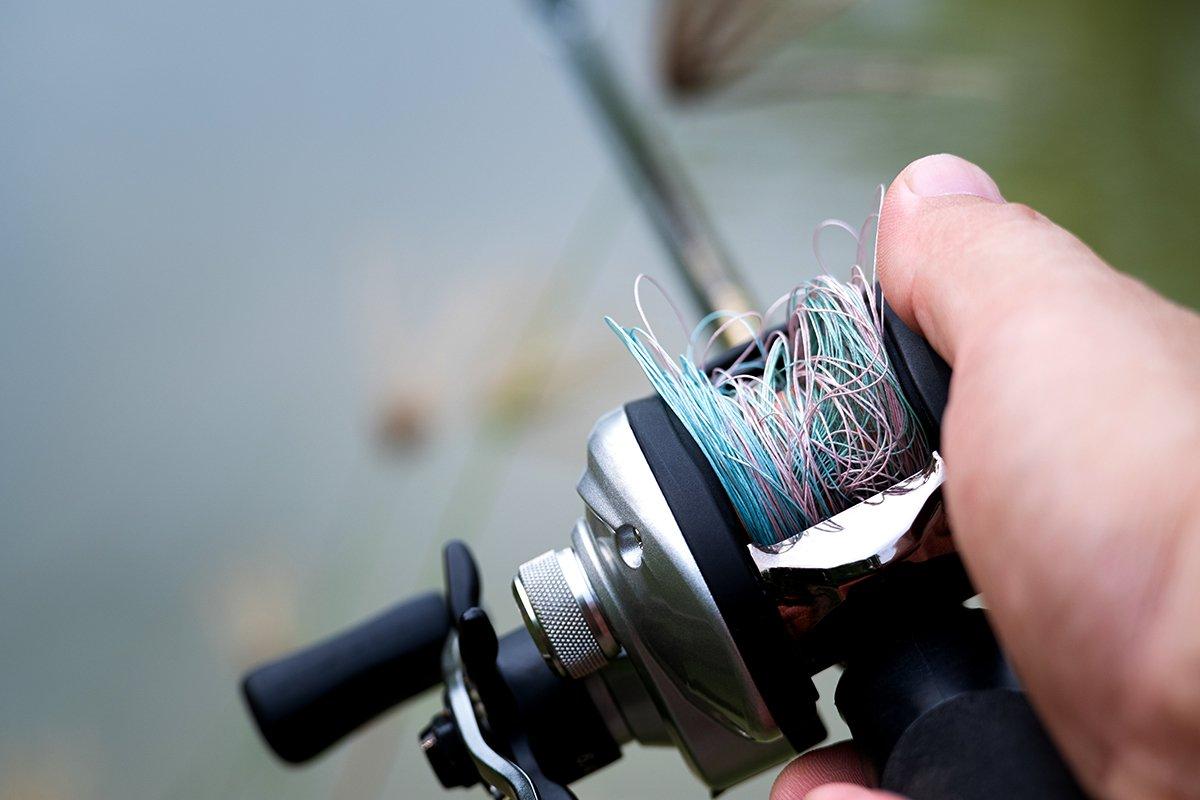Are you spending more time picking out bird's nests than fishing? Chances are the problem is easy to fix
After hours of catching nothing, I finally got my big break. There, just a cast away, several bass corralled a school of shad and were taking advantage of their position by blasting the bait into oblivion and gobbling up the wounded. With the wind in my face, I launched a cast with all my might, sure of an immediate strike. Instead, all I got was an embarrassment in my reel. The dreaded bird's nest. Backlash. Professional overrun.
It's OK, everybody does it. From rookies to pros, we all occasionally blow up a reel. So why do you still suck at throwing a baitcaster? The answer is probably simple.
Let's first look at the problem as a matter of physics. Baitcast reels, by design, are different from every other reel type. In most, the reel spool is stationary and never spins. Line goes out or back in by another mechanism winding it on the spool. However, in a baitcast model, the reel spool is in constant motion, forward and back, allowing line in or out.
The function of controlling spool spin will become second nature, like braking your car at a stop sign without throwing your passenger into the dashboard.
Sounds simple enough. But what new casters don't take into account is that the reel spool doesn't know how to fish. It doesn't have eyes to judge casting distance, or know when an overhanging limb might impede the effort. Nope, all that reel spool knows how to do is spin, forward and back.
Therein lies the problem. A backlash, by definition, is caused by a spinning reel spool that doesn't know when to stop. You make a cast, the lure begins out, and something stops it from continuing motion. That could be the water, a tree, wind, or your hat. The spool spun as line went out, then continued to spin as the line stopped traveling, resulting in an overrun within the reel.
(Killer Buy Alert: Men's Realtree Aspect Sea Foam Fishing Performance Long Sleeve Shirt)
There are a number of common backlash causes. I'd wager that the leading factor is splashdown of the lure itself. Everything is going well, right up to the end of the cast. Then, without fail, an overrun occurs when the lure hits the water.
Here is where practice comes into play. As the caster, we must apply slight pressure to the spool each time we cast, in order to slow and stop it from spinning the instant our lure touches down. You need to thumb it, the old-timers would say. This sounds much more difficult than it really is. Once mastered, feathering the spool becomes second nature, about like setting down your coffee without spilling. The goal is smooth pressure. Seasoned veterans can lay a lure into a tight spot without a splash.
Before we get ahead of ourselves, let's establish a set of rules to give us the best chance to master the cast.
(Don't Miss: The Best Postspawn Crappie Fishing Tactics)
Set the Reel
On nearly every modern baitcast reel, there are two mechanisms in place that control reel spin, one on each side. The mechanism that looks like a protruding knob is called the cast-control. It's usually on the same side as the reel handle. The dial mechanism, often labeled with the numbers 1-10, is the magnetic brake system.
Each plays a role in casting. The control knob is in place to control the tightness of the spool itself, intended to be adjusted for differing lure weights, while the magnetic brake is there to finely tune the reel.
For the sake of our lesson, I'll help you get 90% of the way toward successful casting with easy adjustment. Start on the magnetic side. Adjust your reel to half power. In other words, if your magnetic brake contains settings of 1-10, tune to 5 and stop.
Go to the other side of the reel and tighten the cast control knob so it's snug. Nothing crazy, just righty-tighty with your fingers.
Now with a sizable lure (let's say a 1/2-ounce bass jig) tied on and reeled to the tip of your rod, push your thumb bar to disengage the reel, as you would to cast. The lure should stay stationary and no line should come out, as the finger-tightened cast control knob prevents it. With the reel still disengaged, begin to back off (lefty-loosey) on that knob until the lure begins to drop from the tip of the rod in a slow, steady cadence. Don't hold anything with your thumb. You'll quickly notice that, when the lure falls to the ground, no over-run will occur within your reel.
So that will be our initial reel setting, and will get things off and running. Magnetic dial on half-setting, and a cast-control knob that we set to allow the lure to drop slowly.
Go outside and cast. I know you're scared, but just try it. Don't worry about thumbing the spool or feathering the line or any of that; just cast. What you'll find is that your baitcast reel will not overrun. No backlash will occur. Now, before you think that I've solved one of the great mysteries of your life, know that the lure will not travel very far, and your cast will take on the look of a weakling. But that's OK, because here comes the learning phase.
(Don't Miss: How to Catch Fish During a Giant Bug Hatch)
Train Your Thumb
After a few lacking lobs, turn back that cast control knob just a little. You'll immediately notice a reel spool that spins more freely, and a lure that casts farther. You'll also notice a bit of overrun in the spool once the lure touches down. Keep settings constant, and begin attempting to stop the spool of the reel as the lure touches down. This should be an applied pressure more than an all out stop, right at the end of the cast. After successfully eliminating the overrun with applied pressure, back off the cast control knob even more, and repeat.
You're now training your thumb to feather the spool. Keep things constant — the same line, same lure — and practice a dozen or so casts each time for a few days. The function of controlling spool spin will become second nature, like braking your car at a stop sign without throwing your passenger into the dashboard.
As your journey toward baitcasting mastery continues, you can begin playing with the magnetic control. Be advised: although slight modifications can help you in certain situations, the magnetic braking systems on modern baitcasters are somewhat novelty features. I rarely adjust mine, keeping them around half-strength, and some old-school bassers don't use magnetics at all. In fact, a few reels don't even have magnetic controls.
In any case, magnetic brakes serve a strong purpose when attempting to launch light-weight lures into the wind. A stiff breeze in the face makes bait casting tough for anybody, so consider that when practicing and mastering the technique. And select aerodynamic lures when fishing in the wind; our aforementioned jig is a good example. Avoid long, light lures (balsa wood topwaters and some crankbaits come to mind), or those with wind-catching features, like spinnerbaits with big blades.
Magnetic adjustments can be increased when cast-control knobs are backed off even more, allowing tough-to-cast baits a little more reach. Still, nothing beats the trust of a well-trained thumb and loosening the control knob.
(Don't Miss: 5 Top Lures for Summertime Bass Fishing)
Match It Up
A few more notes on getting set up for success. One, your rod should match your lure or bait. Manufacturer's suggestions printed on the rod can be a good starting point, but they are often too broad to rely on. For most freshwater applications, it's best to start with a mid-sized rod, around 7 feet in length, with a medium power. Line size and type must also be considered.
Nothing backlashes like braided line. Remember that. The lack of memory in braid allows it to overrun with catastrophic results, so start with old-school monofilament. Not only is it easier to cast, but nylon monofilament line allows for simple picking should a backlash occur. Another rule of thumb: lighter lines backlash easier, and worse, than heavier pound-tests. As a general rule, start practice with 14- or 17-pound test and you'll make things easier on yourself.
So, why do you suck at throwing a baitcaster? One, you're intimidated; trust my guidelines to get you past that. Second, you don't practice. Would you buy a new bow and not shoot it before hunting season?
Of course not, so get out there and start casting.
(Don't Miss: Best Lures for Crappie Fishing: Jigs vs. Minnows)









